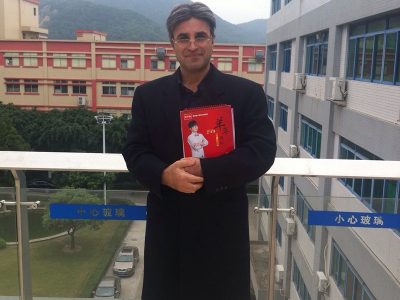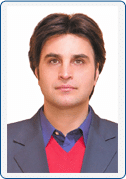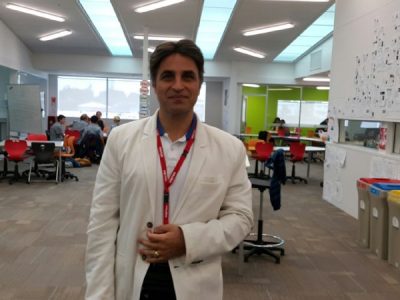I’m Peyman Soltani, and I was born in Tehran in 1965.
I finished my basic education in the National primary School of Bozorg Omid in 14’th district of Tehran, and in 1974, I started middle school at Tawana school in Tehran 13’th district.
I started studying at in Kharazmi high school since 1979 and 4 years later I graduate from high school and got my Diploma. At the end of the same year when I was 18 years old I got my TOEFL certificate in English language.
I took the national entrance exam in 1983, just as Iranian universities were starting to reopen after the Cultural Revolution. I remember that this exam had two stages at the time, and fortunately, I was able to pass both of them. I was then accepted to Shiraz University, where I would major in computer engineering.
Since Shiraz University’s teaching materials are completely in English, during those years (i.e., 1983 to 1988), I was lucky to be able to perform research and study computer publications like Byte and PC Magazine while improving my English in my field of study, I became aware of the direction the computer industry was pursuing. Despite the fact that my area of expertise was hardware, which involved working with tools and accessories, repairing components, and designing electronic and digital circuits. However, I had an interest in software or coding and programming.
I was unconsciously drawn to this profession because I was born into a family with a cultural background and all of my paternal and maternal family were primarily cultural and educational. In 1993, I opened the first computer Institute in the east of Tehran, in the Tehran Pars suburb. I established it by the name of Hoosh Masnoee (Means artificial intelligence).
After a period of less than 2 years, we established Mehrain, Hosh Afarin Computer institutions for girls and Hoosh Avaran Institute for boys with the help of my father, brother and sister. The name of these institutions are well known among residents of Tehran’s eastern suburbs. Additionally, we established a family business to serve and educate children and young people about computers in order to generate employment in this Suburb.
We were able to interact and work closely with the ministry of education through the category of high schools technical schools because the above group of schools were under the direction of the technical and vocational organization. As a result, more than thousands of boys and girls students were successful in earning a diploma in the field of computers. By taking admission examinations and enrolling in public and open institutions, many of these students experienced what it was like to pass the Conquer exams, and we are delighted to see that many of them are now drawn to the business markets.
In 2001, I was able to acquire the first representative office in Tehran from Mojtame Fanni Tehran (Tehran Technical Complex) Institute. After expanding our activities in the east of Tehran in the areas of computer, IT, English language, art, and architecture over the course of two years of continuous activity with Azad Islamic University affiliated to Sama University, we were able to organize joint courses regarding the training of scholars and every year we register the education of scholars. Many recent graduates in the fields of accounting, architecture, and computers enroll in these seminars to hone their abilities.
Perhaps I can look back on 2002 as the turning point in my career as an educator when Mr. Dr. Saeed Saadat, CEO of Tehran Technical Complex, gave me the go-ahead to offer my first ICT course for kids. I started the first smart electronic primary school utilizing ICT and IT as a consequence of the strict implementation after 4 years of continuous activity in numerous schools in Tehran at the elementary and high school levels.
ICT was unquestionably the missing piece in our education system, and with its integration into the system, we can see a departure from daily life in the classroom. To carry out this move, we travelled to advanced countries to closely observe the reasons for the success of education in such countries.
We established the first smart elementary school in the nation, Pishtazan Computer in Iran (Abbreviated as PCI), in the east of Tehran, in the Tehran Pars suburb, as a result of our research and analysis of the educational systems of schools in the United Arab Emirates, England, Holland, Denmark, and Germany. It is a cause of pride and honor for us that this level of work is being done for the first time in the country’s schools, as a result of which, in the summer of 2007, specialists from Sweden visited. The mindset that guided us in developing this school is to create a joyful and upbeat atmosphere that is distinctive and exclusive to all schools, not just in Iran but also worldwide.
The mission of visiting and evaluating has continued since the establishment of PCI School. We have had the privilege of learning from the educational systems of nations like Japan, China, Singapore, Malaysia, Australia, New Zealand, as well as Turkey, Romania, Spain, France, and Austria.
I travelled to Sydney, Australia, in 2015 with my family to finish my doctoral studies in DBA and to apply the profound knowledge I had learned about professional business management. Senior management at Pishtazan schools have applied the following two strategic and distinctive viewpoints since that time:
1- Digital transformation or moving toward digital platform in the management and educational fields.
2- Understanding and using remote management effectively.
During the Corona pandemic, both of these topics became the strength of our schools. We were able to successfully navigate the situation and emerge as a national success story. As a result, following that year, our schools adopted the new slogan “Future-oriented education”” as their official brand.
I’d like to list a few of PCI school’s distinctive qualities in closing for the benefit of the readers of this texts.
1- Employing managers with training and expertise in management, computer, electronics, industries, English, digital marketing, and finance
2-Employing cutting-edge teaching techniques on digital and online platforms
3-Using the most recent hardware, software, and network technologies available today
4-Employing young, energetic, imaginative, and ambitious trainers and teachers in education who are also capable of using educational technologies and content production
5- Professional instruction in music, the English language, computers, and the arts to enhance pupils’ abilities in the third millennium.
6-Using IT to streamline administrative tasks and facilitate speedy communication with parents
7-Putting an emphasis on training that is skill-based and practical, such that for robotics, electronics, and the Internet of Things (IOT).
8- Prompting innovation and creativity in educational topics Using research and analysis of the educational systems of schools in developed countries,.




